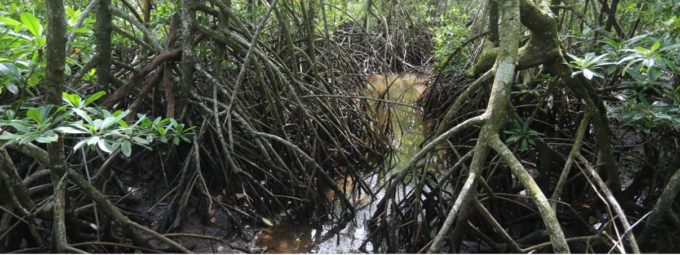
Mangrove deforestation may be releasing more CO2 than Poland, study finds
by Morgan Erickson-Davis — Mongabay
- A new study calculates that, worldwide, mangroves were storing 4.19 billion metric tons of carbon in 2012, representing a 2 percent loss since 2000. It estimates that number had dropped further to 4.16 billion metric tons by 2017.
- In total, the study estimates that this lost carbon translates to as much as 317 million tons of CO2 emissions per year, equivalent to the annual emissions of around 67.5 million passenger vehicles in the United States and more than the 2015 emissions of Poland.
- The researchers found Indonesia harbors the lion’s share of the world’s mangroves — around 30 percent — while also experiencing the biggest proportion of its 2000-2012 mangrove carbon loss, with deforestation there accounting for more than 48 percent of the global total. Other parts of Southeast Asia, such as Myanmar, are also undergoing high rates of mangrove deforestation, making the entire region a hotspot of global mangrove carbon loss.
- Previous research estimates that between 30 and 50 percent of the world’s mangroves have been lost over the past 50 years. Deforestation for shrimp, rice and palm oil are among the biggest drivers of mangrove decline.
Seemingly nondescript messes of tangled branches and exposed roots, mangrove forests cling to the coasts of many tropical countries. However, mangroves are far from unexceptional, providing critical ecosystem services like erosion control, flood mitigation and nurseries for fish. Mangroves also store a lot of carbon, with a hectare of mangrove forest sequestering up to four times as much carbon as a similarly sized tract of rainforest.
But mangroves are in trouble. Studies estimate between 30 and 50 percent of the world’s mangroves have been lost over the past 50 years as they are deforested for shrimp, rice and palm oil production, drowned by rising seas, and starved of freshwater by dam-building. And as mangroves disappear, so do their wildlife communities and carbon stores.
But just how much carbon do mangroves contain, and how much is being lost to their deforestation? To find out, researchers at Salisbury University in the United States. and National University of Singapore analyzed the carbon content of mangrove vegetation as well as the soil underneath it. Their results were published recently in Nature Climate Change.
They discovered that, worldwide, mangroves were storing 4.19 billion metric tons of carbon in 2012. Most of this carbon — 70 percent — is locked up in the soil underlying mangroves while the remainder is contained within their living vegetation. The study lists Brazil, Indonesia, Malaysia and Papua New Guinea as the world’s top mangrove carbon storehouses, comprising more than half of the total amount of global mangrove carbon.
While 4.19 billion metric tons may sound like a lot of carbon, the researchers found that it’s about 2 percent less than the amount stored 12 years prior in 2000. In total, they estimate that this lost carbon translates to as much as 317 million tons of CO2 emissions per year. For perspective, this is equivalent to the annual emissions of around 67.5 million passenger vehicles in the USA, according to EPA numbers, and more than the 2015 emissions of Poland, according to the Netherlands Environmental Assessment Agency.
The researchers found that, globally, mangrove carbon losses were similar year-to-year between 2000 and 2012. They estimate that if mangrove deforestation rates continued at a similar rate after 2012, then by 2017 mangrove carbon should have dropped a further third of a percent to 4.16 billion metric tons.
In addition to estimating how much carbon mangrove deforestation released, the study also looked at the impact of this activity on the mangroves’ overall carbon-sequestering ability. They found that had no mangroves been deforested between 2000 and 2012, then they likely would have taken an additional 3.5 million to 4.5 million metric tons of carbon out of the atmosphere.
Zooming in, the study found Indonesia harbors the lion’s share of the world’s mangroves — around 30 percent — while also experiencing the biggest proportion of its 2000-2012 mangrove carbon loss, with deforestation there accounting for more than 48 percent of the global total. Other parts of Southeast Asia, such as Myanmar, are also undergoing high rates of mangrove deforestation, making the entire region a hotspot of global mangrove carbon loss.
The researchers write that as disappearing carbon storage powerhouses, “mangroves are strong candidates for inclusion in nationally determined contributions (NDCs) to the United Nations Framework Convention on Climate Change (UNFCCC), and payments for ecosystem services (PES) programs that financially incentivize the conservation of forested carbon stocks.”
However, they say that the emissions inventories and monitoring that are used to determine PES compliance require high-quality datasets that exceed their study’s 13-year period. To fill this gap, the researchers recommend more analyses of mangrove carbon stocks and losses, both to establish baselines further back in time — which, they write, are widely lacking for many tropical countries — as well as modeling what may happen in the future.
Citation: Hamilton, S. E., & Friess, D. A. (2018). Global carbon stocks and potential emissions due to mangrove deforestation from 2000 to 2012. Nature Climate Change, 1.












